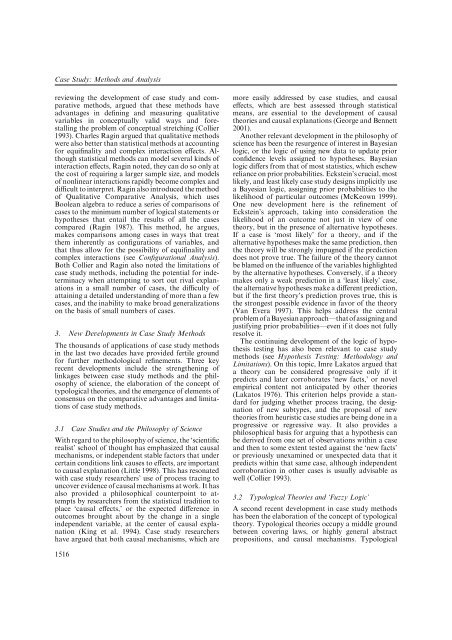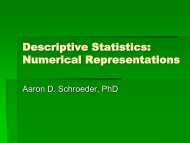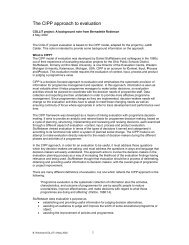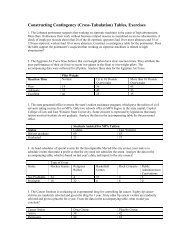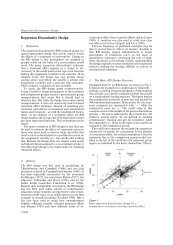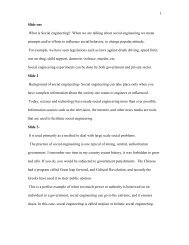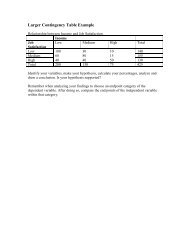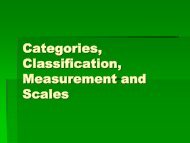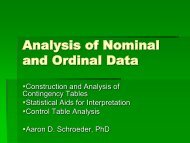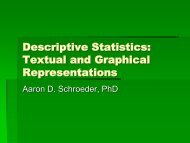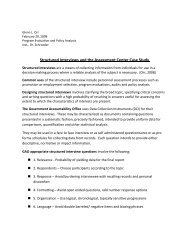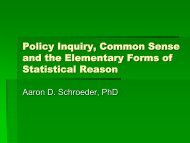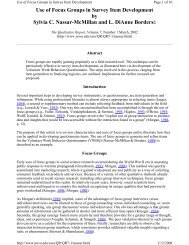Case Study: Logic
Case Study: Logic
Case Study: Logic
Create successful ePaper yourself
Turn your PDF publications into a flip-book with our unique Google optimized e-Paper software.
<strong>Case</strong> <strong>Study</strong>: Methods and Analysis<br />
reviewing the development of case study and comparative<br />
methods, argued that these methods have<br />
advantages in defining and measuring qualitative<br />
variables in conceptually valid ways and forestalling<br />
the problem of conceptual stretching (Collier<br />
1993). Charles Ragin argued that qualitative methods<br />
were also better than statistical methods at accounting<br />
for equifinality and complex interaction effects. Although<br />
statistical methods can model several kinds of<br />
interaction effects, Ragin noted, they can do so only at<br />
the cost of requiring a larger sample size, and models<br />
of nonlinear interactions rapidly become complex and<br />
difficulttointerpret.Raginalsointroducedthe method<br />
of Qualitative Comparative Analysis, which uses<br />
Boolean algebra to reduce a series of comparisons of<br />
cases to the minimum number of logical statements or<br />
hypotheses that entail the results of all the cases<br />
compared (Ragin 1987). This method, he argues,<br />
makes comparisons among cases in ways that treat<br />
them inherently as configurations of variables, and<br />
that thus allow for the possibility of equifinality and<br />
complex interactions (see Configurational Analysis).<br />
Both Collier and Ragin also noted the limitations of<br />
case study methods, including the potential for indeterminacy<br />
when attempting to sort out rival explanations<br />
in a small number of cases, the difficulty of<br />
attaining a detailed understanding of more than a few<br />
cases, and the inability to make broad generalizations<br />
on the basis of small numbers of cases.<br />
3. New Deelopments in <strong>Case</strong> <strong>Study</strong> Methods<br />
The thousands of applications of case study methods<br />
in the last two decades have provided fertile ground<br />
for further methodological refinements. Three key<br />
recent developments include the strengthening of<br />
linkages between case study methods and the philosophy<br />
of science, the elaboration of the concept of<br />
typological theories, and the emergence of elements of<br />
consensus on the comparative advantages and limitations<br />
of case study methods.<br />
3.1 <strong>Case</strong> Studies and the Philosophy of Science<br />
With regard to the philosophy of science, the ‘scientific<br />
realist’ school of thought has emphasized that causal<br />
mechanisms, or independent stable factors that under<br />
certain conditions link causes to effects, are important<br />
to causal explanation (Little 1998). This has resonated<br />
with case study researchers’ use of process tracing to<br />
uncover evidence of causal mechanisms at work. It has<br />
also provided a philosophical counterpoint to attempts<br />
by researchers from the statistical tradition to<br />
place ‘causal effects,’ or the expected difference in<br />
outcomes brought about by the change in a single<br />
independent variable, at the center of causal explanation<br />
(King et al. 1994). <strong>Case</strong> study researchers<br />
have argued that both causal mechanisms, which are<br />
more easily addressed by case studies, and causal<br />
effects, which are best assessed through statistical<br />
means, are essential to the development of causal<br />
theories and causal explanations (George and Bennett<br />
2001).<br />
Another relevant development in the philosophy of<br />
science has been the resurgence of interest in Bayesian<br />
logic, or the logic of using new data to update prior<br />
confidence levels assigned to hypotheses. Bayesian<br />
logic differs from that of most statistics, which eschew<br />
reliance on prior probabilities. Eckstein’s crucial, most<br />
likely, and least likely case study designs implicitly use<br />
a Bayesian logic, assigning prior probabilities to the<br />
likelihood of particular outcomes (McKeown 1999).<br />
One new development here is the refinement of<br />
Eckstein’s approach, taking into consideration the<br />
likelihood of an outcome not just in view of one<br />
theory, but in the presence of alternative hypotheses.<br />
If a case is ‘most likely’ for a theory, and if the<br />
alternative hypotheses make the same prediction, then<br />
the theory will be strongly impugned if the prediction<br />
does not prove true. The failure of the theory cannot<br />
be blamed on the influence of the variables highlighted<br />
by the alternative hypotheses. Conversely, if a theory<br />
makes only a weak prediction in a ‘least likely’ case,<br />
the alternative hypotheses make a different prediction,<br />
but if the first theory’s prediction proves true, this is<br />
the strongest possible evidence in favor of the theory<br />
(Van Evera 1997). This helps address the central<br />
problemofaBayesianapproach—thatofassigningand<br />
justifying prior probabilities—even if it does not fully<br />
resolve it.<br />
The continuing development of the logic of hypothesis<br />
testing has also been relevant to case study<br />
methods (see Hypothesis Testing: Methodology and<br />
Limitations). On this topic, Imre Lakatos argued that<br />
a theory can be considered progressive only if it<br />
predicts and later corroborates ‘new facts,’ or novel<br />
empirical content not anticipated by other theories<br />
(Lakatos 1976). This criterion helps provide a standard<br />
for judging whether process tracing, the designation<br />
of new subtypes, and the proposal of new<br />
theories from heuristic case studies are being done in a<br />
progressive or regressive way. It also provides a<br />
philosophical basis for arguing that a hypothesis can<br />
be derived from one set of observations within a case<br />
and then to some extent tested against the ‘new facts’<br />
or previously unexamined or unexpected data that it<br />
predicts within that same case, although independent<br />
corroboration in other cases is usually advisable as<br />
well (Collier 1993).<br />
3.2 Typological Theories and ‘Fuzzy <strong>Logic</strong>’<br />
A second recent development in case study methods<br />
has been the elaboration of the concept of typological<br />
theory. Typological theories occupy a middle ground<br />
between covering laws, or highly general abstract<br />
propositions, and causal mechanisms. Typological<br />
1516


